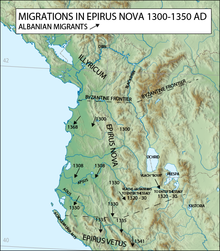Byzantine rule and barbarian invasions
After the region fell to the Romans in 168 BC it became part of Epirus nova that was in turn part of the Roman province of Macedonia. Later it was part of provinces of the Byzantine empire called Themes.
When the Roman Empire was divided into East and West in 395, the territories of modern Albania became part of the Byzantine Empire. Beginning in the first decades of Byzantine rule (until 461), the region suffered devastating raids by Visigoths, Huns, and Ostrogoths. In the 6th and 7th centuries, the region experienced an influx of Slavs.
The new administrative system of the themes, or military provinces created by the Byzantine Empire, contributed to the eventual rise of feudalism in Albania, as peasant soldiers who served military lords became serfs on their landed estates. Among the leading families of the Albanian feudal nobility were the Balsha, Thopia, Shpata, Muzaka, Dukagjini and Kastrioti. The first three of these rose to become rulers of principalities were vassals of the Byzantine Empire, maintaining a partial local autonomy from the Byzantine Empire. Many Albanians converted to the Roman Catholic Church at that period.
In the first decades under Byzantine rule (until 461), Epirus nova suffered the devastation of raids by Visigoths, Huns, and Ostrogoths. Not long after these barbarian invaders swept through the Balkans, the Slavs appeared. Between the 6th and 8th centuries they settled in Roman territories. In the 4th century, barbarian tribes began to prey upon the Roman Empire. The Germanic Goths and Asiatic Huns were the first to arrive, invading in mid-century; the Avars attacked in AD 570; and the Croatian tribes invaded in the early 7th century. In general, the invaders destroyed or weakened Roman andByzantine cultural centers in the lands that would become Albania.[31]
Albania under the Bulgarian Empire
In the mid 9th century most of eastern Albania became part of the Bulgarian Empire. The area, known as Kutmichevitsa, became an important Bulgarian cultural center in 10th century with many thriving towns such as Devol, Glavinitsa (Ballsh) and Belgrad (Berat). When the Byzantines managed to conquer the First Bulgarian Empire the fortresses in eastern Albania were some of the last Bulgarian strongholds to be submitted by the Byzantines. Later the region was recovered by the Second Bulgarian Empire.
The first undisputed mention of Albanians in the historical record is attested in Byzantine source for the first time in 1079-1080, in a work titledHistory by Byzantine historian Michael Attaliates, who referred to the Albanoi as having taken part in a revolt against Constantinople in 1043 and to the Arbanitai as subjects of the duke of Dyrrachium. It is disputed, however, whether the "Albanoi" of the events of 1043 refers to Albanians in an ethnic sense or whether "Albanoi" is a reference to Normans from Sicily under an archaic name (there was also tribe of Italy by the name of "Albanoi").[34] However a later reference to Albanians from the same Attaliates, regarding the participation of Albanians in a rebellion around 1078, is undisputed.[35]
It was in 1190, when a local Albanian noble called Progon created the Principality of Arbër, with its capital at Krujë. After the fall of Progon Dynasty in 1216, the principality came under Grigor Kamona and Gulam of Albania. Finally the Principality was dissolved on 1255.
In 1271 Charles of Anjou after he captured Durrës from Despotate of Epirus, created the Kingdom of Albania. In 14th century a number ofAlbanian principalities were created.
Late Middle Ages
After the weakening of the Byzantine Empire and the Bulgarian Empire in the middle and late 13th century, most of the Albanian territory became part of the Serbian state. Firstly, as part of Rashkaand later as part of Serbian Empire. The southern part was governed by the semi-independent, Serbian ruled Despotate of Epiros. Along with the Serbian ruled Albania, there was also an Albanianstate, the Principality of Arbër, and later the Kingdom of Albania. These three entities, covers the history of Albania between the late 12th century, until the half of the 14th century, when Albanian Principalities were created through all Albania.
Serbian Empire
The Serbs occupied parts of northern and eastern Albania toward the end of the 12th century.
Principality of Arbër
In 1190 the first Albanian medieval state, the Principality of Arbër was founded by the House of Progon with the city of Krujë as the capital. Progoni was succeeded by Gjini and then by Dhimiter.
In 1204, after Western crusaders sacked Constantinople, Venice won nominal control over Albania and the Epirus region of northern Greece and took possession of Durrës. During the Serbian Occupation the first Albanian state of the Middle Ages was created.[citation needed]
Anjou Kingdom of Albania
Main article: Kingdom of Albania
After the fall of the Principality of Arber in territories captured by the Despotate of Epiros, the Kingdom of Albania was established by Charles of Anjou. He took the title of King of Albaniain February, 1272.
The Albanian principalities and the League of Lezhë
Main articles: Albanian principalities and League of Lezhë
In 1368 the Kingdom of Albania was disestablished and several Albanian principalities were formed including the Princedom of Albania, the Principality of Dukagjini, the Principality of Kastrioti, the Principality of Gjirokastër and the Muzakaj Principality of Berat.
In the late 14th and the early 15th century the Ottoman Empire conquered parts of Albania.
The Albanians regained control of their territories in 1444 when the League of Lezhë was established, initially under the rule of George Kastrioti and after his death it was led by Lekë Dukagjini.
In the Middle Ages, the name Arberia (see Origin and history of the name Albania) began to be increasingly applied to the region now comprising the nation of Albania.






0 comments:
Post a Comment